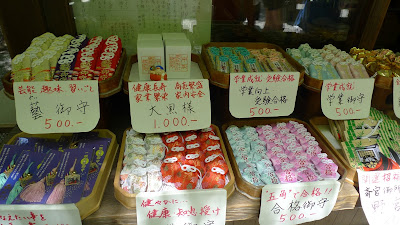26/4/2016
After lunch, we walked across the Togetsukyo Bridge (literally "moon crossing bridge") which spans across the Katsura River and this area is very popular during the Cherry Blossom and Autumn seasons. The first bridge was built in 1836 and each time it was rebuilt after damages caused by flood and war. The present bridge was completed in 1934. The name "Togetsu" (moon crossing) was given by Emperor Kameyama (1249-1305) when he was cruising during a full moon night and the full moon look like it was crossing the bridge.
The bridge marks the point where the Hozu River (on the west side of the bridge) changes its name into Katsura River (the east side of the bridge).
According to the guide, there is ritual at this bridge during the 13th April every year. Young children after praying at the temple nearby will cross this bridge without looking backwards otherwise it will cause them bad luck!
some of the shops
This is hedge is about 50 meters long ... and just realise this place is at the Ginkakuji
This is the one at Sagano Bamboo Grove
the unique Nonomiya Shrine inside the bamboo grove... it has a black (natural colour of the tree trunk) torii gate instead of the usual red!
In the old days, the Emperor would send the unmarried princess to serve as high priestess in the Grand Shrine. This site was originally built as a sacred place for them to prepare and to "purify" maybe abstain themselves for a year before taking up their duties at the Grand Shrine.
Later various deities were enshrined at this place and the most popular being the god of good matchmaking (marriage) and childbirth. There is a "kame-ishi" (Turtle rock) in front and if you touch it while praying, it will grant your wish within a year.
"Shafu" (rickshaw puller) awaiting for customers. Besides many young strong, handsome fellas, we saw a petite woman puller as well! Amazing she can pull this rickshaw around.
walking back to the train station....
traditional Kyoto handicrafts.

The gorgeous Kimono Forest with 600 poles decorated in kyoyuzen (kyota printed silk) .
There is a footbath (water from the Arashiyama onsen) here where you can soak your tired feet... think its the sign behind, and it's a pity that we missed that.
We were due to take the Arashi-Den-Train. This is actually a tram (no air-conditioning and it was a hot day) mainly for tourists along the Sanjo Street, stopping along the way past some of the houses which were very close to the tracks. Yes we can really see into some of the houses by the side of the tracks.
There is a footbath (water from the Arashiyama onsen) here where you can soak your tired feet... think its the sign behind, and it's a pity that we missed that.
We were due to take the Arashi-Den-Train. This is actually a tram (no air-conditioning and it was a hot day) mainly for tourists along the Sanjo Street, stopping along the way past some of the houses which were very close to the tracks. Yes we can really see into some of the houses by the side of the tracks.

Shijo-Omiya Station.
This is the station where you can take the train to Arashiyama if you are staying in Kyoto.

Nishiki Market- aka "Kyoto Kitchen" -
established more than 400 years ago and home of more than 130 shops
young bamboo shoots
wasabi- fresh horseradish
Kyoto is the first place in Japan that tea seeds were planted and therefore it is in Kyoto where Japanese tea ceremony was born.
Uji tencha, ie tea leaves that has been steamed, air dried and de-stemmed and de-vein and is properly ground by stone grind and end result is matcha ie green tea powder. One cup of Matcha is equivalent to 10 cups of brewed green tea and you can learn more about the health benefits of green tea at matchasource.com. Needless to say, this is a must buy for me.
Each of us were given a treat from our guide... grilled squids.
There are also many fish stalls offering fresh sushi on the spot and the girls had a very "tasty" time here.
japanese green peppercorns....
A Rice shop.
Do you know that the premium Japanese brand Nishiki rice is grown in California? This is medium grain variety of Japonica (Japanese) rice and it is especially suitable for making sushi and onigiri rice balls as they become fluffy and sticky when cooked.
Wagyu beef - different grades, different prices.
Kyoto green tea....
the stall where we bought our green tea..
Nishiki market is famous for "Tsukemono" - various pickled veggies... and its free tasting
The Nishiki Tenman-gu Shrine, a city shrine located in the middle of the shopping street of Nishiki market.
This shrine is enshrined with the spirit (deity) of Sugawara Michizane, a scholar during the Heian Period. Hence this shrine is dedicated to god of learning/studies and business.
This well where the Nishiki groundwater bubbles up from 30 meters under the ground. In the old days Nishiki market depended on this water supply.
A green dragon and traditional bamboo ladles. The waters has been tested to have no flavour, no smell and no bacteria!.
The "Petting Cow" ... you can see the shiny surfaces where many hands have rubbed over to bring success in studies. The family crest of Michizane is embossed on the body of the cow- a plum flower.
We have merely touched the surface of Kyoto famous sites and hopefully one day we will be back for a longer visit . We were driven back to the hotel after this.
Photo back at hotel with our guide...
Then it was an early night for us ... have to pack up our luggage for transferring to Tokyo the next day.











































No comments:
Post a Comment